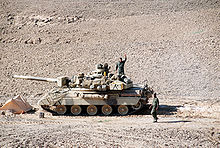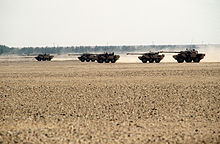- Opération Daguet
-
 An AMX-30 of the French 6th Light Armoured Division bivouaced near Al-Salman during Operation Desert Storm.
An AMX-30 of the French 6th Light Armoured Division bivouaced near Al-Salman during Operation Desert Storm.
Opération Daguet (French pronunciation: [ɔpeʁasjɔ̃ daɡɛ], Operation Brocket Deer) was the codename for French operations during the 1991 Gulf War (also called the Persian Gulf War or Operation Desert Storm). The conflict was between Iraq and a coalition force of approximately 30 nations led by the United States and mandated by the United Nations in order to liberate Kuwait.
The lead up to the war began with the Iraqi invasion of Kuwait on August 2, 1990, following unproven Iraqi contentions that Kuwait was illegally "slant-drilling" oil across Iraq's border. The invasion was met with immediate economic sanctions by the United Nations against Iraq. After a period of diplomacy and coalition forces deploying to Saudi Arabia and other Gulf States, hostilities commenced with air operations on January 17, 1991, resulting in a decisive victory for the coalition forces, which drove Iraqi forces out of Kuwait with minimal coalition deaths. The main battles were aerial and ground combat within Iraq, Kuwait, and bordering areas of Saudi Arabia. The war did not expand outside the immediate Iraqi–Kuwaiti–Saudi border region, although Iraq fired missiles on Israeli cities.
The main coalition nations were:
- United States: 550,000 troops
- Saudi Arabia: 118,000 troops
- United Kingdom: 43,000 troops
- Egypt: 40,000 troops
- United Arab Emirates: 40,000 troops
- Oman: 25,500 troops
- France: 18,000 troops
- Syria: 17,000 troops
- Kuwait: 11,000 troops
- Canada: 4,500 troops
- Philippines: 200 troops (mainly medics)
Contents
Deployment
Soon after the invasion of Kuwait, France sent an additional frigate to augment two French warships already in the Persian Gulf. Operation "Salamandre" is then launched with the deployment of the 5th Regiment of Combat Helicopters (RHC) and a company of the first Regiment of Infantry on board the French aircraft carrier Clemenceau, escorted by the cruiser Colbert and the tanker Var.
On September 14, 1990, Iraqi forces enter the residence of the French ambassador in Kuwait. In response French President François Mitterrand increases the number of troops and aircraft deploying to Saudi Arabia. Soon after, the French intervention is renamed "Opération Daguet" under the command of General Michel Roquejoffre. Additional French reinforcements arrived in December 1990 and January 1991.
The main ground force was the 6th Light Armoured Division(6 DLB), which was reorganised for the operation as the Division Daguet, including the 4th Regiment of Dragoons, almost certainly reassigned from 2nd Armoured Division, and units from the French Foreign Legion. (Most US sources use the 6 DLB designation however.) A full list of divisional units is at fr:Division Daguet. Initially, the French operated independently under national command and control, but coordinated closely with the Americans, Saudis and CENTCOM. In January, the Division was placed under the tactical control of the US XVIII Airborne Corps.
The role of the 6th French Light Armoured Division and the US XVIII Airborne Corps was to protect the theatre left flank and perhaps draw off Iraqi tactical and operational reserves.
The Foudre was sent off to Kuwait to increase medical capabilities.
The naval part of the operation was called "Opération Artimon". From August, it was carried out by three A 69 type avisos, organised around the frigates Dupleix and Montcalm, supported by the tanker Durance. In October, the deployment was reinforced with the frigate Lamotte-Picquet and fleet escort Du Chayla.
In December, the Jean de Vienne and the Premier maître l'Her replaced the Lamotte-Picquet. In March the Jean de Vienne was relieved by the Latouche-Tréville.
The ships enforced the embargo against Iraq by controlling merchant shipping, including 28 586 controls and the boarding of over 1000 ships for further inspections. 14 warning shots were fired. Notably, on the 20th, the Iraqi ship Al Taawin Al Aradien was intercepted by the cruiser USS San Jacinto, the Spanish frigate Infanta Cristina (F34) and the fleet escort Du Chayla (D 630); she refused to comply until warning shots were fired, but refused to be boarded by anyone but the French. A group of Fusiliers de Marine hence inspected the ship.
Prior to the start of air strikes in January 1991, coalition naval forces were operating in the Persian Gulf to enforce sanctions against Iraq. Along with other nations, French warships conducted boarding operations against ships suspected of breaking the sanctions against Iraq. On one such occasion, on 2 October 1990, the French aviso Doudart de Lagree (F 728) [1] intercepted the North Korean vessel, Sam Il Po, which was carrying plywood panels. After the merchant vessel repeatedly failed to answer bridge-to-bridge radio calls, warning shots were fired across the vessel's bow. Sam Il Po then stopped and permitted the French ship to board. [2]
A long series of UN Security Council resolutions were passed regarding the conflict. One of the most important was Resolution 678, passed on November 29, giving Iraq a withdrawal deadline of January 15, 1991, and authorizing "all necessary means to uphold and implement Resolution 660", a diplomatic formulation authorising the use of force. After the deadline passed, on January 17, 1991, intensive air operations began. The majority of missions were flown by the United States, but French Air Force aircraft also took part. SEPECAT Jaguars undertook ground attack missions, Mirage F1s undertook ground attack and reconnaissance missions and Mirage 2000s provided fighter air cover. Mirage F1s were later grounded over concerns that they would be misidentified as enemy fighters by coalition forces since the Iraqi Air Force also operated the Mirage F1.
Compared to losses faced by U.S. and U.K the French suffered no loss of aircraft in any engagements in the war. The French had deployed 40 planes. Four Jaguars were damaged by AAA fires[3].
Operations — ground phase
On the February 24, 1991, the ground phase began. Reconnaissance units of the 6th French Light Armoured Division advanced into Iraq. Three hours later, the French main body attacked. The initial objective for the French was an airfield 90 miles inside Iraq at As-Salman. Reinforced by a brigade from the US 82nd Airborne Division, the French crossed the border unopposed and attacked north. The French then came across elements of the 45th Iraqi Mechanised Infantry Division. After a brief battle, supported by French Army missile-armed Aérospatiale Gazelle attack helicopters, they controlled the objective and captured 2,500 prisoners. By the end of the first day, the French 6th Light Armoured Division, supported by the 82nd Airborne Division had secured its objectives and continued the attack north, securing the highways from Baghdad to southern Iraq.
Casualties
Nine French soldiers were killed during the operation, including two before the beginning of the conflict and five afterwards: a soldier was killed in a car accident in Saudi Arabia in November 1990, and a pilot one month later in the crash landing of his Mirage F1, at the time of a reconnaissance mission in Saudi Arabia. During the conflict, two soldiers of the special force of 1st RPIMa (Sergeant Schmitt and Senior Corporal Éric Cordier) were killed while clearing unexploded U.S. submunitions near Al-Salman on February 26, 1991. 33 others were wounded, including 22 slightly. After the conflict, eight soldiers of the 1st IR were wounded (including three seriously) on March 12, 1991, while going along the Texas road, close to Have-Salman. Two others of the 6th Foreign Engineer Regiment were killed in March and April near Kuwait City, and three died in May, including two in car accidents.
References
- Rottman, Gordon. Armies of the Gulf War. London: Osprey Publishing, 1993. ISBN 185532-277-3
- Cooke, James J. 100 Miles From Baghdad: With the French In Operation Desert Storm. Praeger Publishing, 1993. Cooke, a Mississippi National Guard lieutenant colonel, had been called up for Desert Storm as he was one of few field-grade officers who spoke fluent Arabic. Being also fluent in French, he was sent from XVIII Airborne Corps HQ to be their liaison officer to the Division Daguet.
See also
External links
Categories:- Military operations of the Gulf War
- Wars involving France
- Code names
Wikimedia Foundation. 2010.


